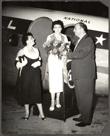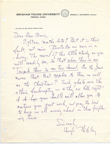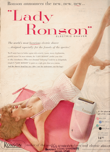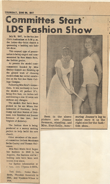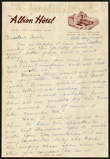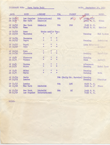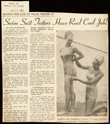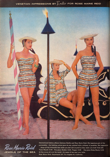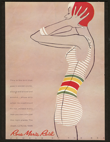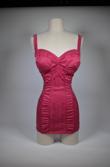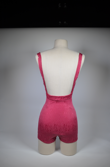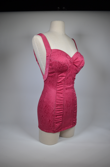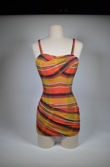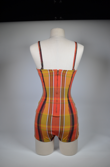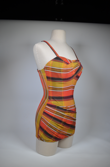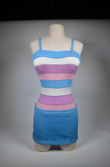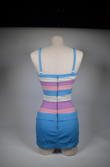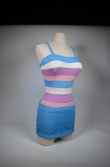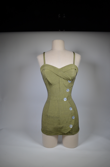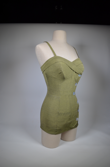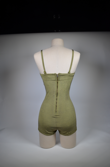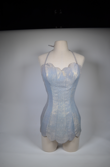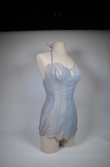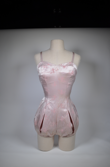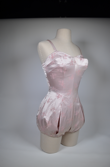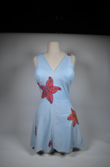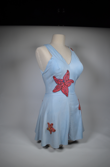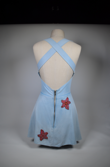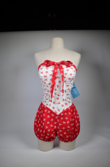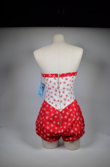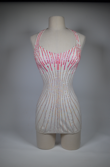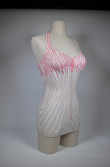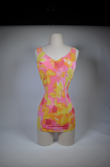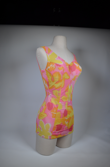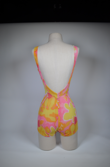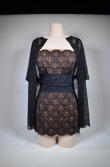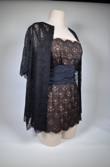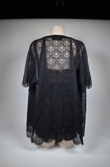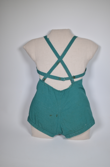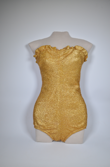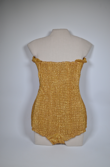VISIT THE EXHIBIT:
INTRODUCTION
From the mid-1930s to the mid-1960s the name Rose Marie Reid was synonymous with beautiful, functional, and innovative women’s swimwear. Rose Marie believed every woman should feel glamorous in a swimsuit, and she designed accordingly, revolutionizing women’s swimwear in ways we take for granted today.
Rose Marie established a global, multi-million dollar fashion empire. Her swimsuits dominated the American market and were popular across Canada, Western Europe, South America, and Australia. Fashion magazines widely advertised her brand, and she collaborated with some of the most creative advertising agencies in North America.
Although she enjoyed financial success, life was not easy for Rose Marie. Her faith in the Gospel of Jesus Christ, however, gave her the strength to endure the many heartaches and challenges she encountered in her personal and professional life. Throughout her life she was a devoted mother, an extraordinary missionary, a generous philanthropist, and a woman of principle. She shared her testimony with anyone who would listen, and when confronted with difficult choices, she never sacrificed her integrity.
VALIANT MISSIONARY
Rose Marie Reid never missed an opportunity to share her religious beliefs with those she met. On business flights she introduced flight attendants to the Gospel and shared her testimony with her fellow passengers. She discussed Church teachings with her models, her business associates, and her neighbors. On one occasion, she even discussed the Gospel with a long-distance telephone operator.
Speaking to a group of students in 1953, Rose Marie remarked: “Tell everyone you meet that you are a Mormon, and then live it to the utmost of your ability.” Rose Marie lived the Gospel to the utmost of her ability. She was generous and kind to everyone she met, and tolerant of others who did not share her convictions. Not everyone, of course, shared her beliefs, but almost all appreciated her sincerity and devotion to the Christian life.
Wrote one individual “I have never spoken or been present at such a gathering and heard a speaker with the faith and humility that you demonstrated.” In a thank you note written to Rose Marie following a fashion show, one gentleman wrote: “Truthfully, I didn’t see your models nor your swimsuits. I only heard what you said about Mormonism—and the way you said it. If an angel had come down straight from heaven … I couldn’t have been more impressed.”
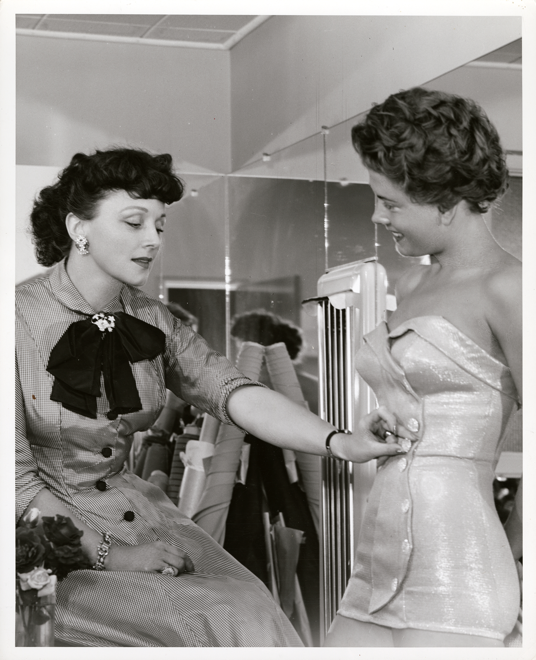
While working with her models, Rose Marie often discussed religion and life with them and frequently read from the Bible or the Book of Mormon. According to model Loraine Eiermann, Rose Marie asked questions “about God, the Bible, and life after death. Religion was an around-the-clock thing in her life [and] for every question I had, she had a beautiful answer.”
In this photograph, c. 1952, Rose Marie is working with a model on the design of the Sea Scallop swimsuit (currently on display).
RELIEF SOCIETY SUIT
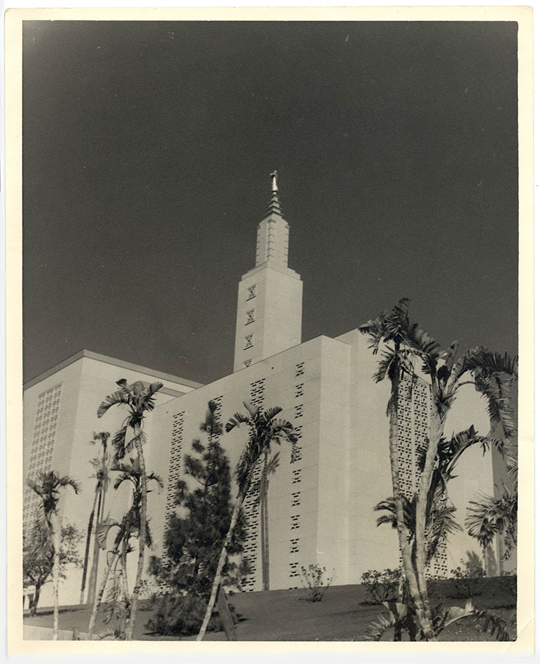
A March 1956 photograph of the Los Angeles Temple in the Rose Marie Reid collection.
On September 22, 1951, LDS Church President, David O. McKay, broke ground for the Los Angeles California Temple. To help raise funds for the construction of the Temple, local members of the Relief Society—the women’s organization of the LDS Church—contacted Rose Marie regarding possible fundraising projects.
Rose Marie, who designed a white Lastex suit with striped lines of sequins in 1954, suggested that the Relief Society sew the sequins onto the suits. Hundreds of LDS women in southern California subsequently devoted thousands of volunteer hours sewing sequins on the “Relief Society” suits.
These “Relief Society” suits were featured in a variety of television programs and fashion and news magazines. Rose Marie donated profits from the sale of these swimsuits to the Los Angeles Temple construction fund. The Los Angeles Temple was dedicated by President McKay in March 1956.
GENEROUS BENEFACTOR
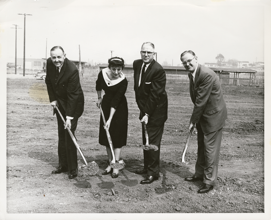
Until the mid-1980s, members of LDS congregations raised funds to build their local ward and stake buildings. To raise these construction funds, local LDS leaders traditionally hosted a variety of fundraising events, including church dinners and bazaars. Rose Marie was regularly invited to be involved at these fundraising events in southern California.
In this photograph, c. 1953, Rose Marie poses with Church leaders at the ground breaking for the Santa Monica Stake Center—one of the church buildings for which she helped raise funds.
Known the world over for her glamorous swimsuits, Rose Marie was the most prominent Latter-day Saint woman of her generation. The demands on her time and resources were constant and unrelenting. While managing a large, multinational corporation, she raised three children and maintained an active role in the ecclesiastical life of her church.
Despite her many commitments and obligations, she still found time to work with LDS missionaries, address young people in her church, speak to college students, organize events for civic groups, promote fundraising activities for California LDS congregations, and give presentations to various Christian and Jewish groups.
Rose Marie was not only generous with her time, she was also an extraordinarily generous philanthropist who gladly shared her wealth to bless the lives of those around her. Rose Marie purchased orthodontia for young women, contributed generously to Brigham Young University, and donated funds to her local community.
CANADIAN ENTREPRENEUR
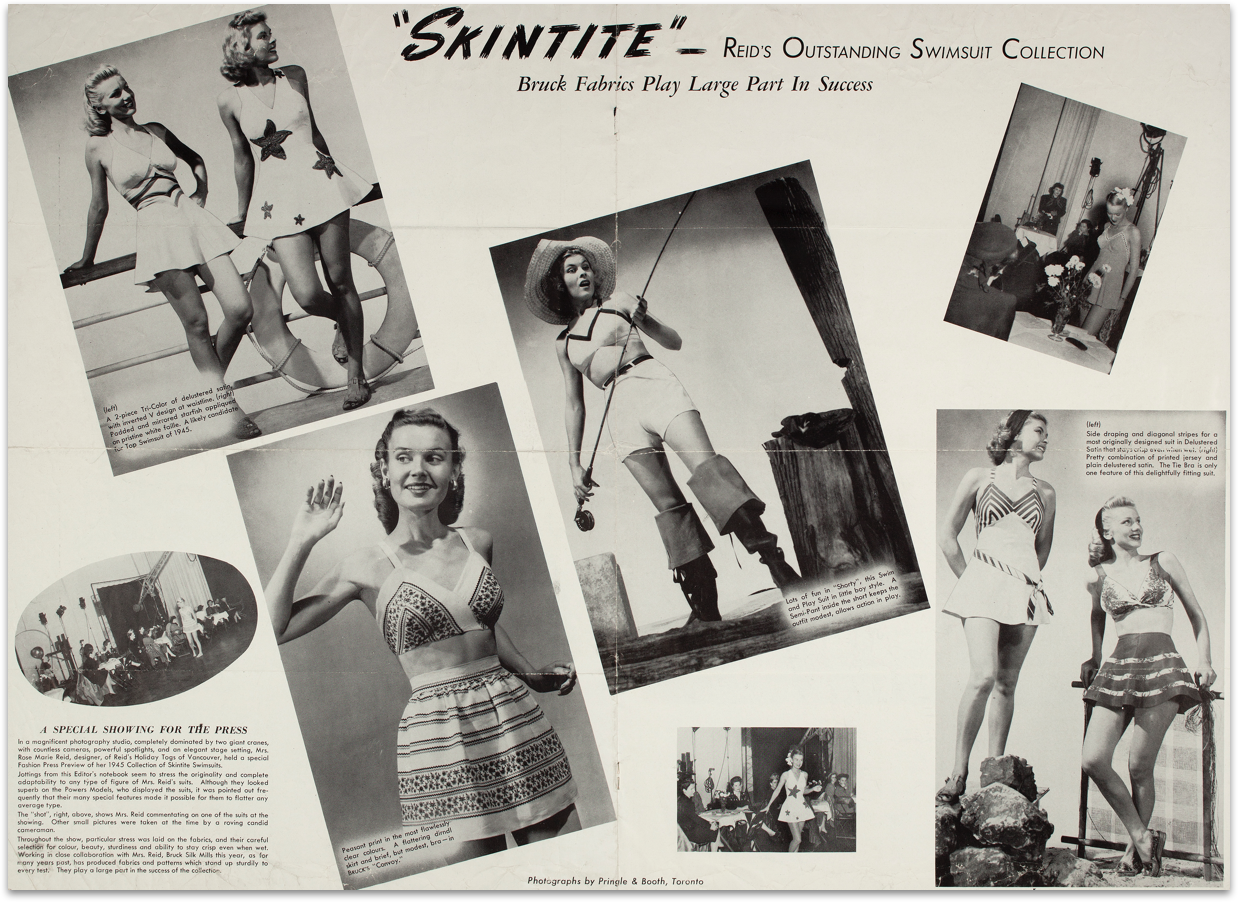
A 1942 advertisement for the Skintite swimsuit line, featuring matching mother-and-daughter suits. Rose Marie’s young daughter Sharon stands at right.
On November 30, 1935, in the midst of the Great Depression, Rose Marie Yancey married Jack Reid, a swimming instructor and athletic manager, in Vancouver, Canada. Jack asked Rose Marie to design him a more functional swimsuit. Jack was so delighted with the lace-up suit she created that he took a duplicate suit to the Hudson’s Bay Department Store. Impressed with the sample swimsuit, Hudson’s Bay requested an example of a lady’s suit and ultimately ordered nearly two hundred additional swimsuits. With that 1936 order, Rose Marie Reid’s first business, Reid’s Holiday Togs, was born.
In her first year of business, Rose Marie employed sixteen employees, grossed $10,000, and designed six suits. Rose Marie’s early suits proved to be popular with swimmers and were used by female athletes in the British Empire Games in Australia. Despite wartime shortages and difficulties, Reid’s Holiday Togs thrived, and Rose Marie successfully introduced her new “Skintite” swimsuit line in 1942. The Skintite suits were extraordinarily popular, and by 1946 sales had reached $834,000.
Unfortunately, in 1946 Rose Marie had no choice but to end her troubled marriage to Jack Reid. Although the end of her marriage was emotionally and financially devastating, Rose Marie succeeded in opening a new Vancouver factory in 1947. Anxious to begin a new life for herself and her children, she also made plans to move her young family to Los Angeles. In describing this move, Rose Marie wrote: “I really wanted to live in the United States . . . and I wanted my children to grow up where they could really have Mormon associations. Fortunately Los Angeles was a place where there were so many Mormons—to say nothing of that wonderful climate.” Rose Marie relocated to California in June of 1949.
WORKING MOTHER

Rose Marie enjoyed taking her children to business dinners and parties. In this photograph, c. 1957, Rose Marie and her children and guests are enjoying a California garden party in the backyard of Jack and Nina Kessler—two of the earliest investors in Rose Marie’s California business (from left to right: Carole Reid, Rose Marie Reid, Bruce Reid, Sharon Reid, Nina Kessler, Jack Kessler).
When Rose Marie married Jack Reid in 1935 her only desire was to raise a happy family. In a 1953 BYU devotional address, Rose Marie stated: “I had not intended to become a designer, although my mother was a designer and had taught me to design. While she was teaching me I used to say, ‘but mother you are wasting your time. I’m never going to design. I’m only going to get married and have children, and keep house, and look after my babies, and that’s all.’”
When her marriage ended in 1946, Rose Marie was confronted with a very different life than the one she had dreamed of. Raised by attentive parents, she took the things she had learned as a young girl—a testimony of the Gospel, the value of hard work, and the skills of a gifted seamstress and designer—and in fairly short order, she forged a new and successful life for herself and her children.
Because of the demands of her business, Rose Marie was always traveling. While she traveled, her mother and sister cared for her children, and Rose Marie made every effort to write and call. When circumstances permitted, she took her children on business trips. In 1938, at ten days old, her baby Sharon was the youngest person to fly across the country. When Rose Marie was home, she took her children to her factory, office, meetings with clients and customers, and fashion shows. One business competitor noted: “I can compete with her swimsuits, and with her selling ability, but I cannot compete with that baby.”
Although Rose Marie involved her children in her business, she also made every effort to protect them from the daily difficulties she experienced in operating a large international business. According to her daughter Carole, Rose Marie “always came home from work happy” and always taught her children that although they did not have a father in the home, they had a Heavenly Father whom they “could always depend on.”
DYNAMIC INNOVATOR
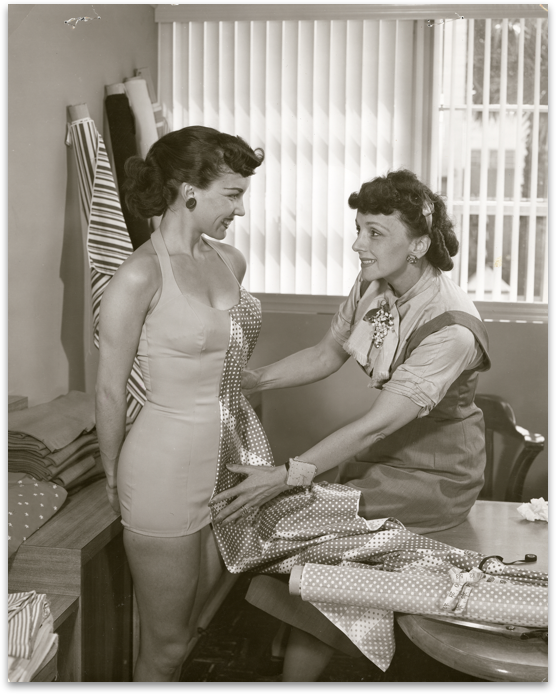
Occasionally Rose Marie worked from preliminary design sketches, but most of her work was done on live models, as shown in this 1956 photograph taken at her Century Boulevard factory in Los Angeles. Rose Marie also insisted on testing all pre-production swimsuits in both fresh and salt water: “I cut and drape on the model and I work with the model in motion, in the water and out of the water. The suit might look gorgeous in a drawing, or on a model who is just standing by the pool, but I want suits to be functional garments for swimming in as well as to be pretty.”
Early in her career Rose Marie realized that to successfully stay ahead of the competition she had to design swimsuits “in a different way than they had been made before.” She accomplished this by designing swimwear for multiple sizes and types of bodies, rather just one standard size, as was the practice of the time. The selection of sizes gave women the opportunity to purchase comfortable, stylish swimwear for the first time. Rose Marie, who cared deeply that women feel lovely wearing their swimsuits, stated: “A woman looks and feels her best when she is wearing an evening dress. . . . I wanted that same feeling in a bathing suit.”
To achieve that feeling, Rose Marie introduced further improvements to swimwear.
Most swimsuits before the 1940s were made from wool and sagged when wet, so Rose Marie introduced attractive, elasticized luxury fabrics to help swimsuits retain their shape. She was the first to incorporate laces, inner brassieres, tummy-tuck panels, stay-down legs, elastic banding, brief skirts, and foundation garments. Her company also patented a machine for fagotting, a laborious crisscross stitch normally done by hand, that became a hallmark of Rose Marie Reid designs. (See below)
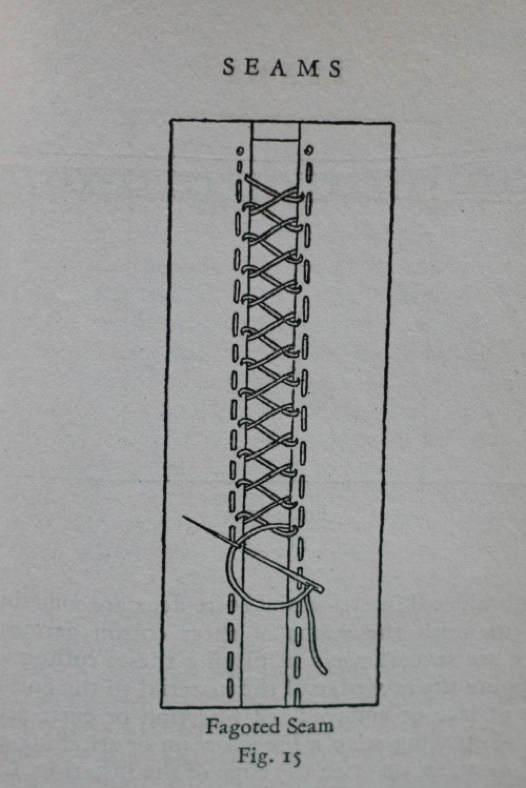
The nuanced designs, refined fabrics, and innovative structuring techniques introduced an aspect of glamour to swimwear that had not existed before, and it inspired a loyal following. As stated by Rose Marie’s close friend, Marjorie Griswald, a fashion buyer for Lord and Taylor: “What customers do know is that your suits do something for them no other suits can do, and when they need a new suit, they will always be back for one of yours.”
SUCCESSFUL BUSINESS WOMAN
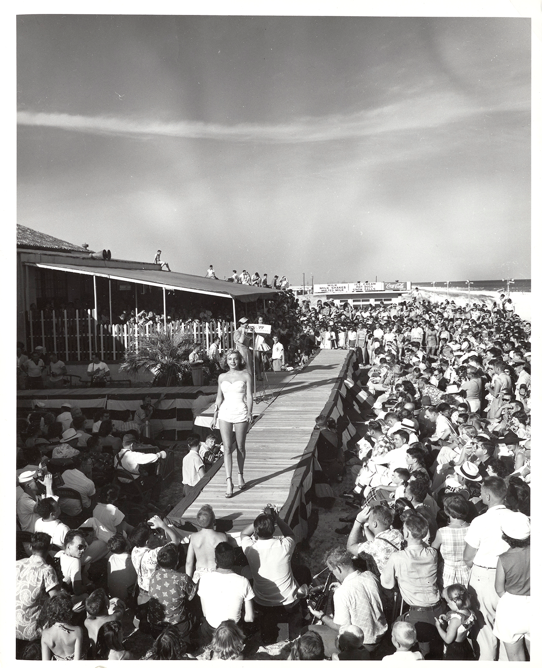
A photograph, c. 1951, of a Rose Marie sales training workshop in Miami Beach, Florida. Rose Marie is standing at the front of the group, speaking into the microphone.
Rose Marie recognized the power of modern advertising and established partnerships with some of the most creative advertising firms in Canada and the United States. She was also an extraordinary sales person. Rose Marie worked closely with sales managers and clerks, coordinated large fashion shows, and developed innovative marketing techniques that have since become standard practice in American business.
Although funding for Rose Marie’s large advertising campaigns was hard to come by early in her career, there was a line she was unwilling to cross. In 1946 Camel Cigarettes offered Rose Marie Reid $250,000 to endorse their cigarettes. Even though her advertising budget that year was only $30,000, she firmly refused Camel’s offer, stating to her colleague, Jack Kessler, “Well, Jack, you know the answer. I couldn’t possibly [endorse a cigarette company].”
In 1950, Rose Marie employed Carson/Roberts, a relatively new advertising agency, to develop and manage her ad campaigns. Carson/Roberts went on to become Los Angeles’ largest advertising firm prior to 1970. Their partnership created some of the most creative and imaginative advertisements of the 1950s.
Carson/Roberts went on to become Los Angeles’ largest advertising firm prior to 1970. Their partnership created some of the most creative and imaginative advertisements of the 1950s.
Her sales strategies and marketing partnerships made the 1950s a wonderful, prosperous time for Rose Marie Reid, Inc. The company’s 1951 gross of $3.5 million increased nearly five fold to $18.1 million by 1960. Combined, her Canadian and U.S. factories increased production between 1952 and 1959 from 1,000 to 10,000 suits per day. Amazed by these figures, Rose Marie remarked: “I have designed every stitch our firm has ever turned out, and I still cannot believe the volume.”
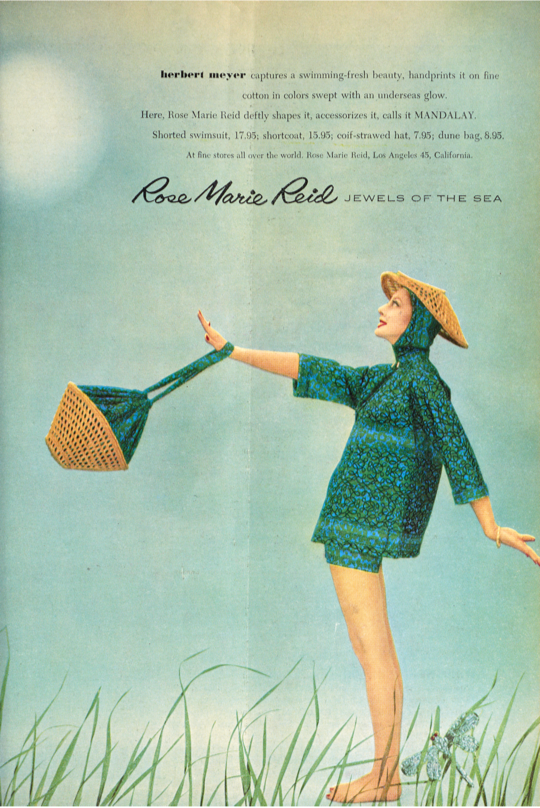
Beginning in the early 1950s, Rose Marie changed the calendar of the swimwear industry by introducing late summer and midwinter lines. She also was one of the first designers to accessorize her swimsuit lines. Her ads often featured not only her swimsuits but also matching “shortcoats,” hats, and bags, as in this 1957 New Yorker ad.
HIGH FASHION DESIGNER
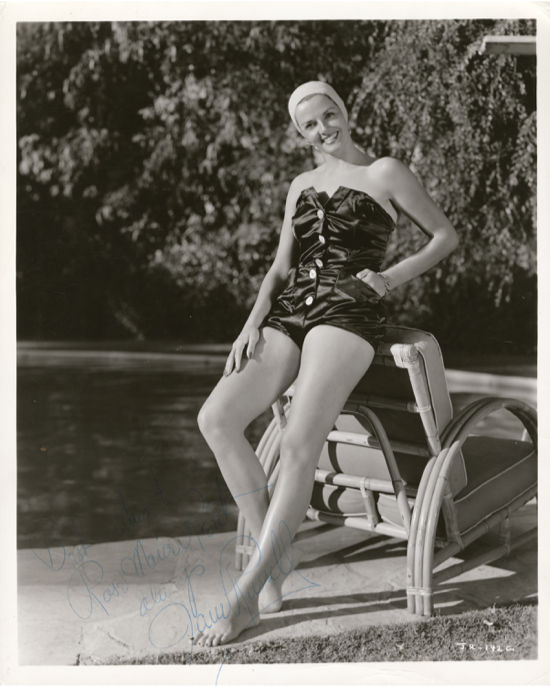
Actress and singer Jane Russell appeared in many Hollywood films, including The Outlaw and Gentlemen Prefer Blondes. In 1948, Russell—an avid swimmer—acquired Rose Marie’s Pearl Diver suit “for year round swimming.” To thank Rose Marie for the suit, she signed this publicity photograph: “Best Wishes to Rose Marie Reid always Jane Russell.”
The popularity of Rose Marie’s swimsuits was driven in part by Hollywood and the motion picture industry. Famous screen actresses, including Rita Hayworth, Marilyn Monroe, Jane Russell and Rhonda Fleming, modeled Rose Marie’s swimwear, and her swimsuits were featured in several California beach party films from the late 1950s and early 1960s, including Gidget, Muscle Beach Party, and Where the Boys Are.
Rose Marie’s swimsuit lines embodied Hollywood glamour and captured the youthful spirit of Southern California beach culture. Her name was known coast-to-coast and her suits, like popular Hollywood films, were exported far and wide.
Rose Marie’s fashion shows and new swimwear lines received extensive coverage in the press, and in the minds of many, Rose Marie herself was a celebrity—a stylish designer similar to the Hollywood stars they admired. For many Americans, California was a magical place, a land of golden opportunities. Many sought to emulate the “California Way of Life” and the purchase of a Rose Marie Reid swimsuit was one way to do just that.
AWARD WINNER

In this photograph, taken in the St. Regis Hotel Ballroom following the Awards ceremony, Rose Marie holds her Award. Models wearing suits from her the award-winning line stand in the back.
On the evening of May 28, 1958, in the St. Regis Hotel in New York City, Rose Marie received the Sports Illustrated Magazine Sporting Look Award.
This award was created to honor “the women’s sportswear designer who, by his or her creation of a distinctive mood, has continuously contributed to the American Sporting Look.”
A committee of six hundred of “America’s top fashion authorities” nominated Rose Marie for this award. The Sporting Look Award marked the high point of her career. Rose Marie had overcome many challenges and difficulties to reach this important moment in her life, and the professional recognition of her peers helped establish her position as one of America’s premier designers.
The Sporting Look Award statue was created by sculptor Sidney Smith and was designed to resemble “a wire dressmaker’s dummy, backed with sport’s traditional laurel wreath of victory.”
GIDGET
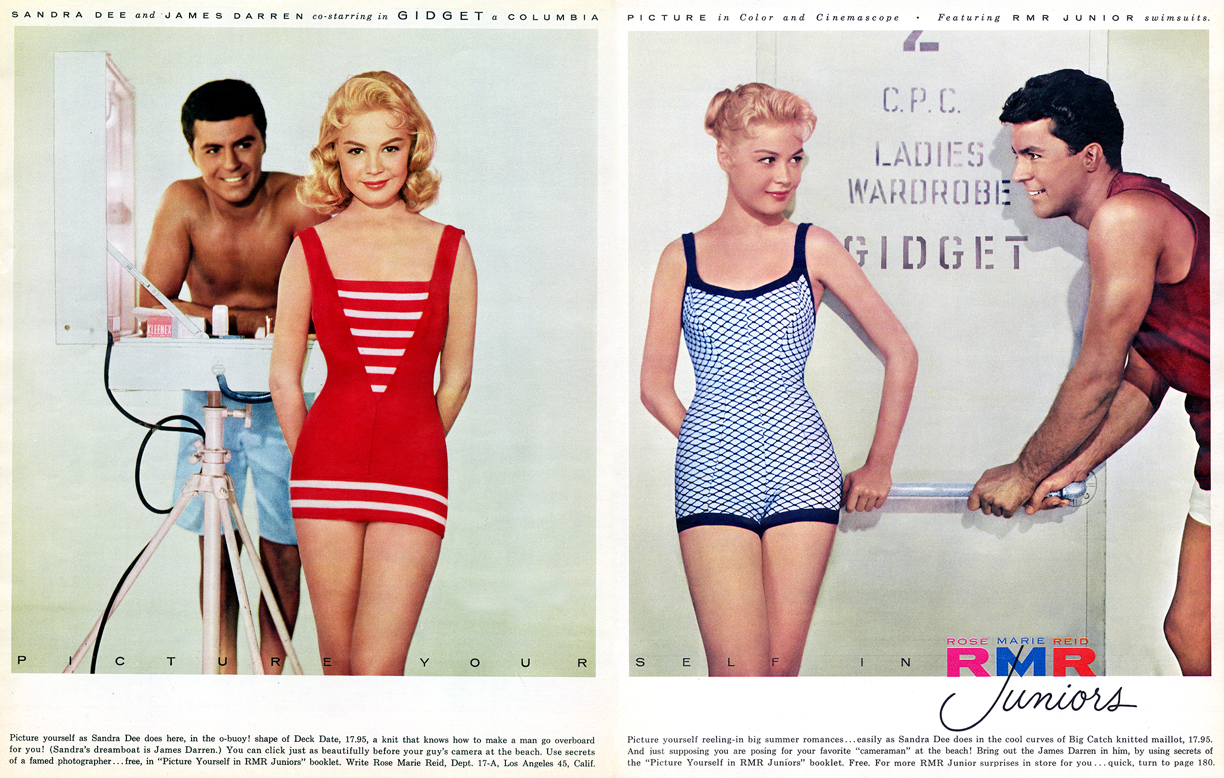
A 1959 two-page advertisement for Gidget and the Rose Marie Reid’s Juniors swimsuit line.
The first Gidget film was produced by Columbia Pictures in 1959 and starred Sandra Dee as Frances Lawrence (Gidget), James Darren as Moondoggie, and Cliff Robertson as The Kahuna. Filmed on Lee Carrillo Beach near Malibu, Gidget was popular with audiences and critics alike.
As a precursor to the 1960s “beach party movies,” Gidget introduced a specifically Southern California “sun and surf” feel to the traditional teenage coming-of-age film. In Gidget, 16-year-old beach bunny Frances Lawrence not only learned to surf but to negotiate the complicated male dominated world of 1950s California surf culture.
Gidget and her female co-stars wore Rose Marie Reid swimsuits throughout the film. Gidget wore a striped knit Chemise suit and her co-star wore the “La Ronde” suit. Sandra Dee and James Darren are also featured in a two-page advertisement for Gidget and the Rose Marie Reid Juniors line.
THE BIKINI
In the late 1950s, Rose Marie was confronted with her most difficult professional challenge—the bikini. Although Rose Marie had been designing modest two-piece suits for women and athletes with long torsos since the 1940s, she absolutely refused to design bikinis or any “immodest bathing suit.” In 1958, Rose Marie emphatically stated: “The bikini has “no future . . . in America,” and in a 1959 interview for The Miami News, she suggested that American women were “basically too modest to accept” bikinis. Like many adults of her generation, however, Rose Marie did not anticipate the vast cultural changes that would transform America in the 1960s.
In the early 1960s Rose Marie’s investors and business partners began to demand that she design and produce bikinis for the American swimsuit market. The issue continued to be debated, and by 1963, Rose Marie realized that she no longer had any choice but to leave her business. As she stated at the time: “I don’t like bikinis, and I don’t want to design for a company that makes them.” Munsingwear acquired Rose Marie Reid, Inc., in the mid-1960s and continued to produce swimwear under Rose Marie’s name, but she was no longer associated with the business she had created.
SACRED CLOTHING
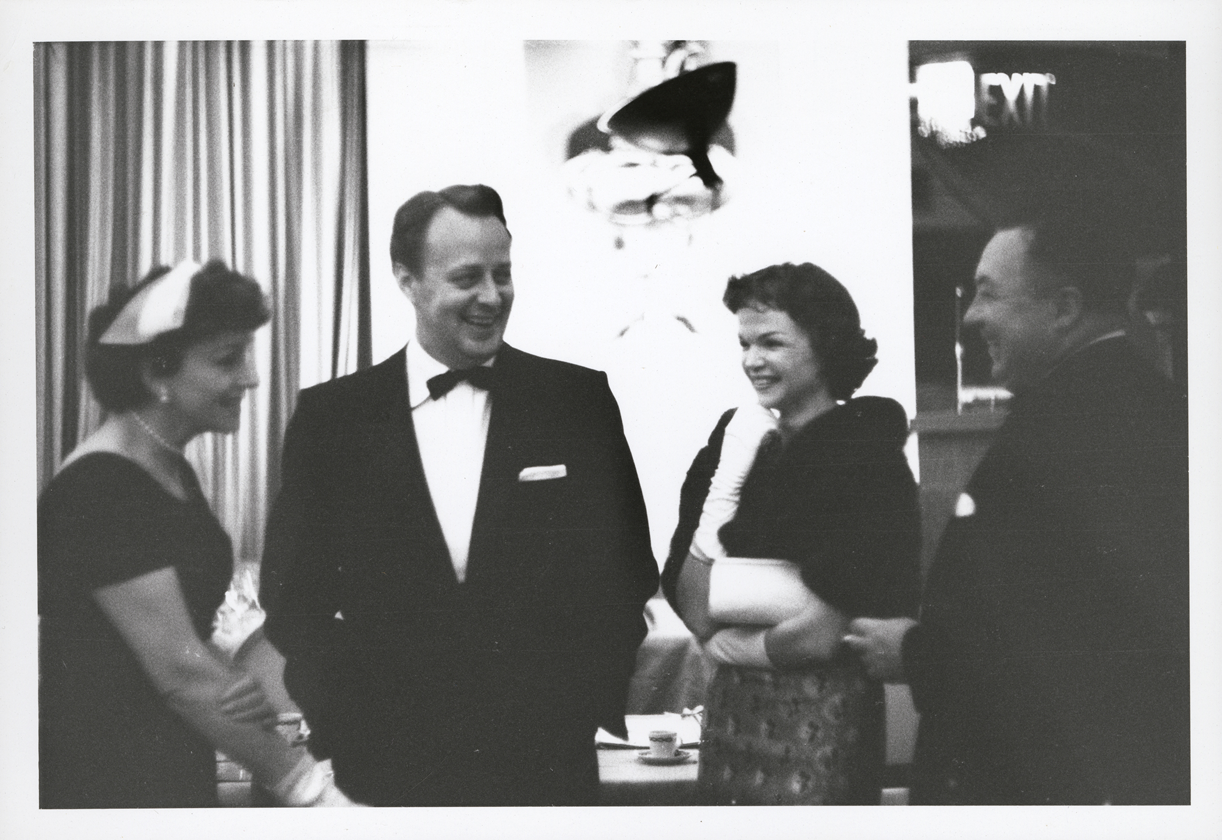
Rose Marie worked closely with her friend and professional colleague Robert Derx, Vice-President of Marketing for Vanity Fair Lingerie, to identify manufacturers of lightweight, attractive fabrics for use in the production of the temple garment.
In the late 1950s, LDS Church President, David O. McKay, and Relief Society General President, Belle Spafford, asked Rose Marie to create standard patterns, sizes, and styles for the production of the LDS temple garment. Rose Marie considered this the most important Church calling of her life. She believed that it was “a great privilege” to wear the temple garment and considered them “wonderful and beautiful and sacred and precious.” Rose Marie wanted Latter-day Saint women to be comfortable and feel lovely in this sacred clothing.


